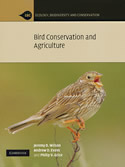
Publisher: Cambridge University Press, Cambridge
Publication Year: 2009
Binding: 1
Page Count: 394
ISBN Number: 978-0-521-73472-1
Price: £35.00
Bird Conservation and Agriculture
This book, by authors who have all played central roles in the field, provides a valuable summary of the huge research area that is ‘farmland birds’. The book is well-organized, starting with an introduction to the history of farming and birds, which feels a bit superfluous given Mike Shrubb’s books on the subject, and then introducing the habitats that make up ‘farmland’. The in-field, productive area is considered as separate from the field boundary (hedges and margins), while semi-natural grasslands and heathlands are also separated out, reflecting the fact that they are fundamentally agricultural and are dependent on particular types of management to survive.
Subsequent sections describe the research into the patterns of population change that caused conservation concern in the first place and then studies of the causes of decline and what can be done about it. The text provides a very thorough and balanced summary of the research in each of these areas, taking the reader from the diagnosis of population declines through correlative analyses of associations with environmental change to extensive studies of demography and distributions at large-scales and the local-scale intensive work that has complemented them. The book ends with an account of research developing and testing options for agri-environment schemes, concluding that research is still needed to produce a suite of measures and a delivery mechanism that works, followed by a look at the future challenges and research priorities in the field.
Although this is an admirable and thorough piece of work, it does have weaknesses. It is inevitable that any summary of a fast-moving field will immediately be out-of-date, but it is unfortunate that farmland could now be in the midst of a major step-change with the loss of set-aside and the advent of the Campaign for the Farmed Environment just as the book appears. In addition, the issue of effects of predation on farmland bird populations remains controversial and, while all the evidence is covered in the book, it could be a missed opportunity not to confront it head-on with a chapter reviewing all the available information. Finally, this book is a summary of research, not a review: there is little critical evaluation of the strengths and weaknesses of different studies or approaches, just descriptions of their results. Nevertheless, the book provides an excellent introduction to the field and is certain to become an important reference text for anyone who is interested in farmland biodiversity.
Book reviewed by Gavin Siriwardena





Share this page